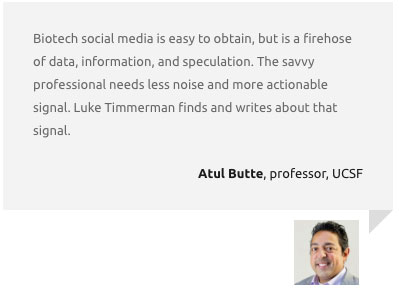Defend the NIH

Luke Timmerman, founder & editor, Timmerman Report
Too many people don’t believe anymore in the American Dream.
But if you can’t dream big, you can’t accomplish big things.
Today, the National Institutes of Health — biomedical science itself — is under attack. It needs us to stand up in its defense. The NIH is an engine of the American Dream.
The NIH, with a $47.7 billion a year budget, is a force for human health and the economy. It has catalyzed the economy for decades. It attracts the best and brightest young scientists from around the world to come do their work here, to build their lives here.
Think about just one NIH project, the Human Genome Project. The budget hawks of the 1990s called it a costly boondoggle, a giant waste of money. It became a seed investment for the ages. It cost $3.8 billion between 1990 and 2003. What did we get? Through 2010, the estimated economic impact was $796 billion, according to a Battelle study.
That’s $141 of economic activity for every $1 invested by the US government. That’s right — a 141X return on investment!
The dividends don’t stop there. That calculation was made in 2010. Biotech would be in the dark ages today without that DNA code on every desktop, and the ability to sequence DNA at high speed and low cost. You can draw a straight line between that catalytic investment by the US government (and to a lesser extent the UK, France, Japan and others), and biopharma’s invention of dozens of cancer drugs, life-changing treatments for rare diseases, and mRNA vaccines for COVID-19.
The Human Genome Project is only one success story. There are many others. One 2024 study found that for every $1 we taxpayers spend on the NIH, we get $2.64 in economic activity. This is the best return on investment we get from federal government spending.
The NIH, composed of 27 institutes, supports the best work in cancer, infectious disease, neuroscience, mental health and other fields.
Ordinary citizens in the US have no idea that our taxpayer dollars can have this kind of impact. They have no idea that when we send our $47.7 billion to Washington for the NIH, 85 percent of that money gets circulated right back to the states that are home to so many vibrant universities.
People have no idea that the NIH money is divvied out on a competitive, merit-based grant review system. Or that the institutes themselves are led and staffed by brilliant hard-working people from around the world.
People have no idea that you and me — the US taxpayer — are by far the most powerful investors in biomedicine. No country in Europe invests at this magnitude. China? It has ambition. But it envies the NIH system, seeks to copy it, and knows it still has a long way to go.
Citizens in the US tend to have an exaggerated view of what billionaires like Bill Gates and Warren Buffett can do. Drinking from the poisoned chalice of political entertainment media for far too long, we’ve internalized the idea that government is full of screw-ups, and business titans like Gates and Buffett are the true wellsprings of science and innovation.
Generous as they are, their impact pales by comparison to the US taxpayers. The Bill & Melinda Gates Foundation, the world’s largest philanthropy, invests $5 billion a year across all its programs that include education, global development and global health. The NIH pumps $47.7 billion into biomedical research alone for the American people. The Gates Foundation knows this, and it’s why they are always talking about partnerships. They know the NIH is the beating heart of biomedical research.
We as a country just don’t fully appreciate what a gem we have in the NIH.
In my state of Washington, the late Sen. Warren Magnuson brought home the bacon that built the University of Washington Health Sciences Center and the Fred Hutchinson Cancer Center. These are sparkling stars in my community, and in the global scientific enterprise.
Sen. Magnuson operated in the optimistic post-WWII era, guided by FDR’s science advisor, Vannevar Bush. It’s worth re-reading Bush’s seminal document “Science, the Endless Frontier.”
When Vannevar Bush wrote that visionary document in 1945, we hadn’t even discovered the double helix structure of DNA.
Imagine how much further we could go today with a reinvigorated NIH.
Instead of sabotaging our country’s global advantage in biomedical research with indiscriminate budget cuts, we should triple down on our investment. Here are a few ideas that bolster the Midwest, address increasing diseases, and build on our existing biomedical leadership:
- A new NIH intramural campus, located West of the Mississippi. The NIH campus in Bethesda, Maryland currently has about 6,000 research scientists. I’m thinking of a new 5,000 or 6,000-scientist campus in a Midwestern or Western city. It could be an attractive place for young families, a place with affordable housing, cultural amenities, existing biomedical building blocks, and good transportation bones to handle an influx of newcomers. St. Louis would work. It’s the home of Washington University in St. Louis, it’s the Gateway to the West, and a major American city that has lost 65 percent of its population since its peak in 1950.
Why do this? Planting a major research stake in the ground, outside of Washington DC, New York, San Francisco or Boston could have multiple benefits. We would get good bang for our taxpayer investment, with lower operating and capital expenses. A new NIH campus would spur surrounding economic development with housing, transportation, small business. It would send a powerful cultural message that this 21st century industry creates shared prosperity, not just prosperity for a few coastal cities.
Putting an NIH campus in St. Louis would give young scientists a place to spread their wings and get established – where they could make the same wage as in a place like Bethesda but where their salary would support a higher standard of living. Not only that, but a fresh new campus would create some healthy competition for Bethesda and help bust out of moldy Groupthink patterns of thought.
A St. Louis NIH campus could attract fresh new thinkers. I’m reminded of Nobel Laureate Mario Capecchi, who left Harvard University to go to the University of Utah to get away from some of the suffocating aspects. At Utah, free to do his own thing, he invented knockout mouse technology. (Capecchi, by the way, is a Holocaust survivor and orphan who found refuge in the US. He’s a poster boy for immigration reform, but that’s another column.)
- Build up four new cornerstone institutes of the NIH. We could support areas that need more basic research. I’m thinking of a reborn National Institute of Infectious Disease, a beefed-up National Institute of Mental Health, and a more generously funded National Institute of Neurological Disorders and Stroke.
Why do this? These institutes are traditionally underfunded, especially compared with the big dog at NIH – the National Cancer Institute ($7.2 billion annual budget). But look at the future of disease burden. There’s SARS-CoV-2 and flu and malaria, TB and HIV. Then depression and anxiety and schizophrenia and bipolar disorder. Then Alzheimer’s and Parkinson’s and multiple sclerosis.
We’re talking about diseases affecting tens of millions of people worldwide.
Biopharma invests little in these areas because these fields are less mature than cancer, and because there’s less government-funded basic research to build on. There simply are not as many promising, short-term angles for industry R&D to attack. That was true for cancer in 1970. But then President Nixon and leaders in Congress (including Sen. Magnuson) made a big bet on the National Cancer Institute.
That investment is paying dividends today. The death rate from cancer has fallen 33 percent since 1991, according to the American Cancer Society.
We can achieve gains like this for many more patients. We are in a biology renaissance. The needs for human health are enormous and growing. The US government is by far the most powerful force in the world for this kind of catalytic investment. The NIH is capable of creating entirely new industries.
With NIH as the bedrock, along with a vibrant biotech industry, the US should be able to create hundreds of new drugs and diagnostics and vaccines over the next 100 years. We have a generation of talented young people that are yearning for purpose and meaning in work.
Let’s stand up against the cynicism and pessimism that is infecting our country.
Let’s defend the NIH budget. Let’s continue to lead the world in biomedical research.
Let’s continue to pursue this variation of the American Dream.





